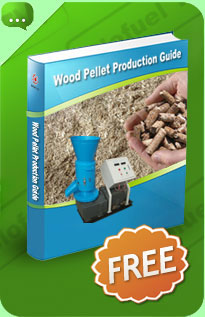Homemade Pellet Machine
To make a homemade pellet machine is technically possible; however is neither cost effective nor a practical option. To be able to consistently and efficiently process wood into fuel pellets, required some fairly heavy engineering to cope with the forces involved.
Making Pellets With a Small Pellet Mill
On the BiofuelTech website we promote a range of small pellet mills which can be used in the home. These pellet mill are of a high quality, and very affordable as the prices are directly from the manufacturer. Small pellet mills are generally all flat die pellet mills. The flat die pellet mill is a vertical design. The rollers sit on top of the die, applying pressure vertically to the top surface of the die. Depending on the design, either the roller shell or die will be stationary and the other will rotate. Material enters from the top, and falls between the rollers and die. The pellets come through the bottom of the die, and are cut to length via a knife. Pellet length is much more important than many people appreciate. Some pellet stove augers cannot handle oversized pellets, causing damage to the auger or simply blocking and causing the stove to stop operating properly, therefore shorter pellets are better.
One view that many people in the pellet production market including BiofuelTech share is that pellet production is more of an art than an exact science. The reasons for this are each raw material has its own unique characteristics. Part of the differences lie in the percentage of natural lignin found within the raw material. Lignin is the natural binding agent found in all biomass materials, under the heat and pressure of the pellet mill the lignin is melted. Once the pellet has been formed the lignin cools to produce pellets.
Biomass and Pellet Mills For Home Use
Before the raw material is suitable for the pellet mill, it first must be prepared correctly. For example if you wish to produce 6mm pellets, which is the size of pellet most pellet stoves use, you must provide the pellet mill with a raw material of 6mm or below. Therefore this means sawdust is appropriate, however wood chips are going to require more processing. After wood has been chipped, the best piece of equipment to reduce the chips further in size is a hammer mill. A hammer mill works on the principle of attrition. Through the speed impact of the hammers on the wood chips, the chips are shattered into smaller particles. To make sure the particles are below 6mm a screen is placed in the hammer mill. Therefore no particles can escape the hammers until they are below 6mm in size.
Once the material is off a suitable size, generally is must be dried before entering the pellet mill, this is particularly true is the wood chips are from fresh virgin wood. For small scale pellet production, the most practical and affordable way of drying the material is through a flash dryer. Flash dryers are also known as pipe dryers or air current dryers. The hot air is generated in the stove burning wood logs, chips or pellets. From the stove there is then a series of pipes with expansion chambers. A fan pulls the wet material through the pipe, in doing so exposing the wet particles to the hot air from the stove. At the end of the pipe system a cyclone separates the dry material.
We also offer one of the few small ring die pellet mills which can be used in the home. The mini pellet mill has specifically designed to run from single phase power, and consumes below 2kws of power, that's comparable to running your kettle.

